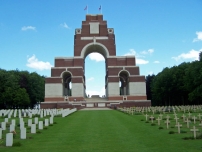| First Name: | James | Last Name: | MUIR | |
|---|---|---|---|---|
| Date of Death: | 07/10/1916 | Lived/Born In: | Limehouse | |
| Rank: | Private | Unit: | London14 | |
| Memorial Site: | 1. Limehouse, St Anne 2. Thiepval Memorial, France | |||
Current Information:Enlisted-Stepney
The Battle of the Somme (July-November, 1916) By the beginning of October, 1916, the Battle of the Somme had been raging for three months. Thousands of men had already been killed or wounded or were simply missing, never to be seen again and and just a few square miles of the French countryside, all in the southern part of the battlefield, had been captured from the enemy. Mistakes had been made by the various commanders and would be continued to be made but there was no turning back as the British, Australians, South Africans, New Zealanders and Canadians carried on battering away at the German defences in the hope of a breakthrough, So it continued all the way through to November with nearly every battalion and division then in France being drawn into it at some stage. In the end the German trenches had been pushed back a few more miles along most of the line but the cost in lives had been staggering. By the end of the fighting in November, 1916, British Army casualties numbered over 400,000, killed, wounded and missing. The Battle of Transloy Ridge On 1st October, 1916, a new offensive was begun by the British Army. The Battle of Transloy Ridge was the last major operation fought during the battle of the Somme and it continued throughout the first three weeks of the month until the terrible conditions of rain, mud and cold coupled with the sheer exhaustion of the troops, brought things to a standstill. The aim had been to push the enemy further back to the next ridge of higher ground running between Le Transloy and Warlencourt. It was a very hard fight, progress was painfully slow, the casualty figure was shockingly high and the final objective was not achieved despite the best efforts of the attacking divisions. Three factors worked against its success. The first was the weather. It was simply awful. The second was the miles of war torn terrain which soon became a quagmire over which troops, guns, ammunition and all the other supplies had to cross to reach the front and keep the momentum of the offensive going. For the Germans, falling back on their own supply lines across relatively unscathed ground, this was not such a problem. The third factor was the new methods of defence employed by the enemy. They defended in depth without a well defined front line but instead setting up machine-gun nests in shell holes and other strategically important sites where just a few men could hold up an entire battalion. And of course, the German artillery had the whole area covered. 7th October, 1916, was a costly day for London on the Somme and by the end of it some 750 men from the capital had lost their lives and many thousands more were wounded. The second stage of the offensive, which had been delayed by the bad weather, was launched on this day and both London divisions, 56th Division and 47th Division were fully involved. 56th Division attacked on the extreme right of the British line with the French on their right. Their objectives were to capture the German trenches in front of them after which a second wave of men would move forward to the crest of the ridge covering the village of Le Transloy. The attack was made at 1.45pm by 1st London and 7th Middlesex of 167 Brigade and the 4th London, 12th London and 14th London battalions from 168 Brigade. At 1.45pm 14th London attacked on the right flank of 168 Brigade, next to the French who were also involved in the offensive. One source claims that this was arranged because many of 14th London spoke French, but this sounds a bit dubious. In order to maintain an element of surprise the attack was made without the benefit of a preliminary artillery barrage of the enemy positions but even so the Germans must have known that they were coming, because the leading companies met fierce machine-gun fire. Indeed, that morning, one of their spotter planes had seen the troops packed into the assembly trenches all along 56th Division’s front and the German artillery had opened up, causing many casualties before the attack started. Despite this the two leading companies of 14th London took their objectives after some fierce hand to hand fighting but a lack of similar success on their left and right meant that both their flanks were exposed and they were forced to withdraw back to their starting line. Their casualties were many. B Company was reduced to one officer and eighteen men. One of those who did not survive the day was James Muir, who was killed in action. |
||||
| « Back to Search Results | ||||
| If you think any of the information shown here is incorrect, Click Here to submit your amends and comments | ||||




